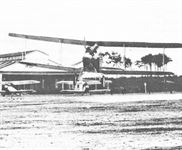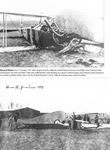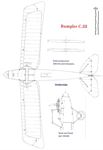
Описание
Страна: Германия
Год: 1916
Фронтовой самолет
Варианты
- Rumpler - C.I/C.Ia - 1914 - Германия
- Rumpler - 6B1/6B2 - 1916 - Германия
- Rumpler - C.III/C.V - 1916 - Германия
- Rumpler - C.IV - 1916 - Германия
- Rumpler - C.VII / Rubild Mb - 1917 - Германия
- Rumpler - C.VIII - 1917 - Германия
- В.Кондратьев Самолеты первой мировой войны
- O.Thetford, P.Gray German Aircraft of the First World War (Putnam)
- J.Herris Rumpler Aircraft of WWI (A Centennial Perspective on Great War Airplanes 11)
-
J.Herris - Rumpler Aircraft of WWI /Centennial Perspective/ (11)
Rumpler C.III First Prototype
-
J.Herris - Rumpler Aircraft of WWI /Centennial Perspective/ (11)
Rumpler C.III Second Prototype
-
J.Herris - Rumpler Aircraft of WWI /Centennial Perspective/ (11)
Rumpler C.III Early Production
-
J.Herris - Rumpler Aircraft of WWI /Centennial Perspective/ (11)
Rumpler C.III 1873/16 "6" of Flieger-Abteilung 19 in original markings.
-
J.Herris - Rumpler Aircraft of WWI /Centennial Perspective/ (11)
Rumpler C.III 1873/16 "6" of Flieger-Abteilung 19 in 1918 markings and, apparently, one-color upper surface camouflage..
-
J.Herris - Rumpler Aircraft of WWI /Centennial Perspective/ (11)
Rumpler C.III of the Wireless Operators Training School
-
O.Thetford, P.Gray - German Aircraft of the First World War /Putnam/
The Rumpler C III two seater was a development of the widely used C I with the one major difference that it lacked any form of fixed fin. In the event, this deletion was to be the design's downfall. Using a 220hp Benz Bz IV, the C III entered service in early 1917, but was withdrawn from operations within a month or so following a spate of crashes, attributed to the machine's lack of adequate latitudinal, or yawing control at low speed. It is reported that around 75 C IIIs had been delivered by Rumpler prior to the type's withdrawal from service.
-
J.Herris - Rumpler Aircraft of WWI /Centennial Perspective/ (11)
A Rumpler C.III prototype is shown here. Although it looks very similar to the later and more well-known C.IV, it has a curved rudder without fixed fin, and had inadequate directional stability. The raised decking behind the observer's cockpit was soon replaced by a conventional design. All controls were aerodynamically balanced.
-
J.Herris - Rumpler Aircraft of WWI /Centennial Perspective/ (11)
This side view of the Rumpler C.III prototype emphasizes its clean lines. Although all controls are aerodynamically balanced, the curved rudder without fixed fin is clearly too small. The photo was taken on 22 August 1916.
-
J.Herris - Rumpler Aircraft of WWI /Centennial Perspective/ (11)
The Rumpler G.III prototype is ready for a flight with both crewmen. The streamlined nose entry, including large propeller spinner, shows the design team's search for better performance through reduced drag.
-
J.Herris - Rumpler Aircraft of WWI /Centennial Perspective/ (11)
Only the under-nose cooling air intakes and radiator over the engine mar the Rumpler C.III prototype's clean lines. Test instruments are mounted on the front, outboard, starboard interplane strut.
-
J.Herris - Rumpler Aircraft of WWI /Centennial Perspective/ (11)
Powered by the 200 hp Benz Bz.IV, the prototype Rumpler C.III shows its refined lines in front of the Rumpler factory. The C.III was a transitional type that underwent continual modifications to improve performance and flying qualities. Production machines had a normal turtledeck behind the observer, perhaps for a better field of fire. Many German designs initially omitted a fixed fin, probably to minimize weight and drag, but this almost always led to stability problems that had to be solved by addition of a fin; the Rumpler C.III was no exception. Early production machines had no fin; later production machines had a fin. All controls were aerodynamically balanced.
-
J.Herris - Rumpler Aircraft of WWI /Centennial Perspective/ (11)
The Rumpler C.III prototype seen from the front quarter shows its marked resemblance to the later C.IV. Several cooling intake vents underneath the nose differentiate this prototype from the production C.III and later C.IV. Test instruments are mounted on the front, outboard, starboard interplane strut. The propeller was made by Axial.
-
J.Herris - Rumpler Aircraft of WWI /Centennial Perspective/ (11)
The supplementary air intakes seen beneath the nose on the Rumpler C.III prototype in its original configuration have now been eliminated, and only a modest grill beneath the nose remains. The turtle-deck is also conventional now; this appears to the configuration for the early production C.III.
-
J.Herris - Rumpler Aircraft of WWI /Centennial Perspective/ (11)
The unusual turtle-deck behind the observer's cockpit seen on the Rumpler C.III prototype in its original configuration has now been replaced by a conventional turtle-deck, most likely to give the observer a less obstructed field of fire. The aerodynamically-balanced ailerons and elevators are clearly visible.
-
J.Herris - Rumpler Aircraft of WWI /Centennial Perspective/ (11)
The Rumpler C.III prototype taking off on a test flight at the Rumpler factory.
-
J.Herris - Rumpler Aircraft of WWI /Centennial Perspective/ (11)
The Rumpler C III was powered by the Benz Bz IV. Built in small numbers. It was instrumental in developing the airframe for the more powerful and successful C.IV which used the Mercedes D IVa.
This appears to be an early production Rumpler C.III at the front. There is still no fixed fin but the turtledeck is conventional and the supplementary cooling intakes beneath the nose seen on the prototype are also gone. The iron cross national insignia now have white outlines instead of being applied over a square white background. The ailerons and elevators retain their aerodynamic balances. -
J.Herris - Rumpler Aircraft of WWI /Centennial Perspective/ (11)
Early production Rumpler C.III 'F15' is from the wireless operator training school. Again it has no fixed fin and no supplementary cooling intakes beneath the nose. The iron cross national insignia have white outlines and the overall color is darker than the typical Rumpler factory camouflage of the time. The dark characters 'F15'on the fuselage side have been outlined in white for greater visibility.
-
J.Herris - Rumpler Aircraft of WWI /Centennial Perspective/ (11)
This rare late production Rumpler C.III lasted at the front until early 1918 as indicated by the Balkenkreuz insignia. The rudder is now white. It also carries the unit insignia of Flieger Abteilung 19. The names Tetzner and Schneider were written on the back of the photograph; were these the crewmen?
-
J.Herris - Weird Wings of WWI /Centennial Perspective/ (70)
This late production Rumpler C.III with unbalanced elevators carries the unit insignia of Flieger Abteilung 19. Other than its use of the Benz engine, from the side it looks like a Rumpler C.IV. The lower wing tip shape, difficult to see clearly from this angle, is the most visible difference between the late C.III and early C.IV.
-
J.Herris - Rumpler Aircraft of WWI /Centennial Perspective/ (11)
Rumpler C.III 1873/16 of Flieger-Abteilung 19 rests between missions. Only one C.III remained at the front into 1918 and, from the late national insignia, it was probably this aircraft.
-
J.Herris - Rumpler Aircraft of WWI /Centennial Perspective/ (11)
Rumpler C.III 18xx/16 illustrates the intermediate production configuration. It has the revised vertical tail with fixed fin to improve stability, and both the ailerons and rudder are now unbalanced. However, the elevators are still balanced. This transition took place sometime between serial 1869/16, an early configuration machine, and 1898/16, representing the final production configuration.
-
J.Herris - Rumpler Aircraft of WWI /Centennial Perspective/ (11)
LVG C.II 2135/15 is at left foreground and three late-production Rumpler C.III aircraft rest in the right foreground on 16 April 1917. Interestingly, there are no insignia on the rudders of the C.III aircraft. A Rumpler C.I is in the center background with another LVG C.II at right background.
Другие самолёты на фотографии: LVG C.II - Германия - 1915Rumpler C.I/C.Ia - Германия - 1914
-
J.Herris - Rumpler Aircraft of WWI /Centennial Perspective/ (11)
This photo shows Rumpler C.III 1898/16 after it landed near Elverdinghe on 31 August 1917 and was given the British captured aircraft designation G66. Examination of factory component markings revealed the upper wing was manufactured on 16 Nov. 1916 and the lower wing was manufactured on 27 Nov. 1916. Despite being slightly damaged, the camouflage and markings are nicely visible. This Rumpler C.III represents the final production configuration; all control surfaces are unbalanced. It looked very much like a Rumpler C.IV; the real differences were the engine and the squared-off lower wing tip planform so clearly shown here.
-
J.Herris - Rumpler Aircraft of WWI /Centennial Perspective/ (11)
This photo shows Rumpler C.III 1898/16 after it landed near Elverdinghe on 31 August 1917 and was given the British captured aircraft designation G66. Examination of factory component markings revealed the upper wing was manufactured on 16 Nov. 1916 and the lower wing was manufactured on 27 Nov. 1916. Despite being slightly damaged, the camouflage and markings are nicely visible. This Rumpler C.III represents the final production configuration; all control surfaces are unbalanced. It looked very much like a Rumpler C.IV; the real differences were the engine and the squared-off lower wing tip planform.
-
J.Herris - Rumpler Aircraft of WWI /Centennial Perspective/ (11)
Side view of an early Rumpler C.IV prototype, perhaps the first, shows the unusual rear fuselage fairing behind the observer's cockpit that was later removed. There is no propeller spinner and no opening for a fixed gun for the pilot. It looks very similar to the Rumpler C.III prototype and was clearly designed at nearly the same time.
Side view of an early Rumpler C.IV prototype, perhaps the first, shows the unusual rear fuselage fairing behind the observer's cockpit that was later removed. It was similar to the C.III prototypes. There is no propeller spinner and no opening for a fixed gun for the pilot. It looks very similar to the Rumpler C.III prototype and was clearly designed at nearly the same time. Replacement of the 200 hp Benz Bz.IV with the 260 hp Mercedes D.IVa was the key difference between the types. -
M.Dusing - German Aviation Industry in WWI. Volume 2 /Centennial Perspective/ (85)
Rumpler C.V (1916-18)
-
J.Herris - Rumpler Aircraft of WWI /Centennial Perspective/ (11)
An early-production C.III has suffered a rough landing. This view shows a window in the cockpit floor and a control rod under the fuselage.
-
J.Herris - Rumpler Aircraft of WWI /Centennial Perspective/ (11)
Late-production Rumpler C.III 1898/16 after it landed near Elverdinghe on 31 August 1917.
-
J.Herris - Rumpler Aircraft of WWI /Centennial Perspective/ (11)
Feldwebel Niemeier of Fl.Abt. (A) 250 suffered control failure during a flight in this early-production C.III, w/n 1497. Unfortunately, the military serial number is not visible in the photo. The C.III was designed as lightly as possible for the best climb and ceiling, and numerous modifications had to be made to strengthen the airframe based on experience.
-
J.Herris - Rumpler Aircraft of WWI /Centennial Perspective/ (11)
Rumpler C.III 1903/16 shows its revised vertical tail with fixed fin and balanced elevators, representing the middle production configuration. Lightly built to achieve high altitude, it has suffered damage to the rear fuselage and balanced elevators. Both C.III and early C.IV aircraft, which shared their airframe, had to be modified at the factory to strengthen the rear fuselage. Later C.IV airframes included these changes in production.
-
J.Herris - Rumpler Aircraft of WWI /Centennial Perspective/ (11)
On 17 January 1917 pilot August Quoos suffered control failure during a test flight near Colmar in this production C.III, work number 1466, and suffered this crash landing as a result. Unfortunately, the military serial number is not visible in either photo.
-
J.Herris - Rumpler Aircraft of WWI /Centennial Perspective/ (11)
Early-production C.III work number 1474 has suffered a bad landing - and again the military serial number is not visible in the photos! The large number of crash photos of production Rumpler C.III aircraft despite the relatively small number built is an indication that further development of the control system and flying qualities was needed.
-
J.Herris - Rumpler Aircraft of WWI /Centennial Perspective/ (11)
Early-production Rumpler C.III 1869/16, work number 1470, is down in the snow, likely as a result of a bad landing. The pilot's fixed gun, factory camouflage and aerodynamically-balanced controls are clearly visible.
В.Кондратьев Самолеты первой мировой войны
Румплер C-III / RUMPLER C-III
Дальнейшим развитием удачной машины стал C-III - самолет с улучшенной аэродинамикой, более мощным мотором, синхронным пулеметом "Шпандау" и бомбовой кассетой в фюзеляже. Это был в самом широком смысле слова универсальный аппарат, способный выступать во всех ролях, от бомбардировщика до перехватчика.
"Троек" построили довольно мало - всего 75 штук, так как уже в конце 1916-го появился еще более усовершенствованный образец - C-IV.
ДВИГАТЕЛЬ
"Бенц", 220 л.с.
ВООРУЖЕНИЕ
1 синхронный "Шпандау" и 1 турельный "Парабелум", а также - до 100 кг бомб.
Описание:







































